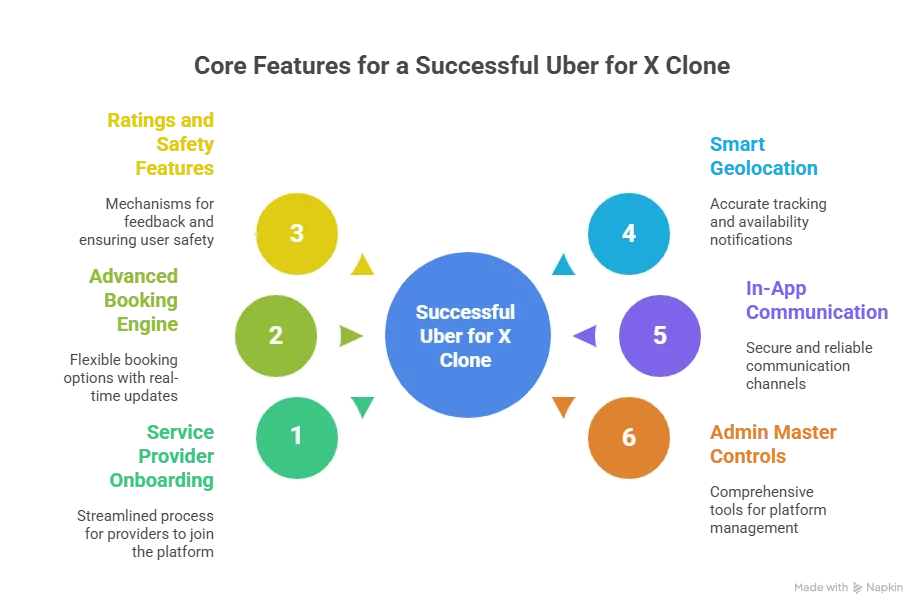Back in the early 2010s, Uber changed how we hailed a ride. But something else happened under the radar—it inspired a whole new startup wave across every industry imaginable. Uber for food, Uber for laundry, Uber for mechanics. You name it. And in 2025, this model is still booming. People want services instantly. Entrepreneurs want plug-and-play apps. That’s where Uber for X clone scripts come in—your shortcut to launching an on-demand empire without the tech headaches
Let’s say you’re eyeing a gap in your local market. Maybe no one’s delivering dog walkers or on-demand tutors. Maybe your city lacks a solid home cleaning app. Whatever the niche, Uber for X is the blueprint that works. A user taps a button, books a service, tracks progress, pays digitally, and rates the experience. It’s universal, flexible, and scalable
At Miracuves, we’ve helped brands build platforms for every vertical from car wash to caregiving. Uber for X clone scripts are no longer rigid templates—they’re modular, white-label launchpads for ambitious founders. If you’re ready to build something that people depend on every day, let’s break down the best scripts and what to look for
What Is an Uber for X Clone Script?
An Uber for X clone is a generic on-demand app framework that can be tailored for any service vertical—plumbing, beauty, car repair, tutoring, moving, babysitting, and so on. It typically includes a customer app, provider app, and admin dashboard. Think of it as the “Lego kit” of the on-demand tech world
Instead of coding from scratch, you get a pre-built architecture that handles real-time booking, location tracking, service availability, payments, ratings, and notifications. You can tweak the service list, booking logic, pricing models, and even the visuals to match your brand. That’s the power of clone tech in 2025—it’s built to bend without breaking
Read More : Uber for X Features That Drive Success
Core Features That Make or Break Uber for X Clone Scripts

Service Provider Onboarding
Your app should support profile creation, KYC upload, service zone setup, availability scheduling, and service pricing. No clunky dashboards—simplicity wins
Advanced Booking Engine
Let users choose immediate or scheduled service. Support hourly, task-based, or subscription pricing. Real-time status updates are essential
Ratings, Disputes & Safety
Both parties should be able to rate, review, and report issues. Emergency call buttons, masked numbers, and ID verification features add trust
Smart Geolocation & Availability
Your script needs to show nearby service providers, track ETA, and notify users if someone becomes available or cancels
In-App Communication
Chat and voice calling between customers and providers should be encrypted, instant, and uninterrupted—even in low-network areas
Admin Master Controls
An Uber for X isn’t just for users—it’s for operators. The admin panel should offer detailed analytics, payout reports, commission management, promotional controls, and push notification tools
Read More : Launch Smart, Grow Fast: How Our Uber for X Clone Powers Startup Scalability
Price Tiers: What to Expect in 2025
Starter Scripts ($1,500–$3,000)
You’ll get the basics—booking, maps, payments—but with limited customization and little post-sale support. Good for testing small ideas, but not robust for scale
Mid-Level Packages ($3,500–$6,500)
More services, better UI, full branding, and real backend tools. You can add 2–3 service categories and get decent post-launch support
Enterprise Solutions ($7,000–$14,000+)
If you’re serious, this is your playground. Full code ownership, multi-country support, AI-based provider matching, marketing dashboards, and advanced APIs for integrations. These clones are future-proof and made to grow with you
Uber for X Cost Factors & Pricing Breakdown
Uber-for-X Multi-Service On-Demand Platform — Market Price
| Development Level | Inclusions | Estimated Market Price (USD) |
|---|---|---|
| 1. Service Booking MVP | Customer + provider apps, real-time scheduling, service categories, wallet, geo-tracking, reviews, admin panel | $25,000 |
| 2. Full Multi-Service Marketplace | Multi-city support, surge pricing, subscription packages, payouts, multi-vendor analytics, promo engine | $75,000 |
| 3. Enterprise-Grade Super-App | 200+ services support, fleet management, franchise expansion, AI automation, heat maps, advanced dispatch routing | $150,000+ |
Miracuves Pricing for an Uber-for-X Platform
Miracuves Price: Starts at $3,299
Miracuves provides a production-grade, ready-to-launch multi-service super-app engineered for on-demand operations across multiple categories such as Home Cleaning, Beauty & Salon, Repair Services, Tutors, Electricians, Plumbers & more—built for real-world scale and automated growth.
Note
This includes full non-encrypted source code, complete deployment support, backend/API setup, admin panel configuration, and publishing assistance for Android & iOS—ensuring a fully operational platform ready for launch and expansion.
Launch Your Uber-for-X Multi-Service Marketplace Faster While Others Spend $75,000+ and Wait 6–12 Months — Contact Us Today
Delivery Timeline for an Uber-for-X Platform
3–6 Days, depending on:
- Number of service categories
- Area coverage & region settings
- Payment gateway configurations
- Provider onboarding workflow
Tech Stack
Built using robust frameworks — Web using PHP, MySQL & Apps using Flutter, optimized for performance, stability, and easy maintenance.
Pros and Cons of Uber for X Clone Scripts
Pros
Time-Saving: Skip the dev time—build your niche app in weeksModular: One backend, multiple services. Scale as you growAffordable: Get enterprise-grade tech without VC funding
Cons
Design Similarity: Without solid UX input, your app may look like dozens of othersIntegration Load: Customizing too many services at once can delay launchThird-Party Dependencies: Some clones rely heavily on third-party APIs—watch for license costs
Popular Use Cases That Shine in 2025
- Uber for Mechanics: Roadside assistance with real-time tracking
- Uber for Home Services: Combine cleaning, electrical, plumbing in one app
- Uber for Tutors: One-click booking with lesson tracking and video call integration
- Uber for Pet Services: Grooming, walking, sitting—all in-app
- Uber for Beauty: On-demand makeup artists and stylists with location-based search
Emerging Trends in the Uber for X Space
- Hyperlocal Marketplaces: Think smaller areas, tighter community integration
- Subscription Models: Users pay monthly for a set number of service bookings
- AI Matching: Smart pairing based on user preferences and provider ratings
- AR/VR Support: For remote consultations (especially in wellness and repairs)
- Green Service Filters: Eco-conscious users want to filter providers based on carbon footprint
Conclusion
Uber for X clone scripts aren’t just technical short-cuts—they’re launchpads for big ideas. Whether you want to disrupt one vertical or unify multiple, the right clone can give you momentum, market traction, and monetization from day one. In a time when users demand everything on tap, your on-demand idea could be the next local favorite or even a global success. The only question is—what’s your X?
At Miracuves, we help innovators launch high-performance app clones that are fast, scalable, and monetization-ready. Ready to turn your idea into reality? Let’s build together
FAQs
Can I launch multiple service categories on one app?
Yes, most Uber for X clones support multi-service options with separate provider modules for each
How do I decide what niche to build for?
Look at your local pain points—what services are missing or inefficient? That’s your X
Do these apps work in countries with low connectivity?
Yes, but make sure to optimize maps, caching, and payment flows for 2G/3G environments
Can I restrict services to certain locations?
Absolutely. Geo-fencing and zone-based service controls are standard in most premium scripts
How do I ensure provider quality?
Use onboarding filters like background checks, document uploads, and admin approvals before going live
Is it hard to scale an Uber for X app?
Not if the script is modular. You can add services, expand to new cities, and integrate more tools over time without downtime
Related Articles








